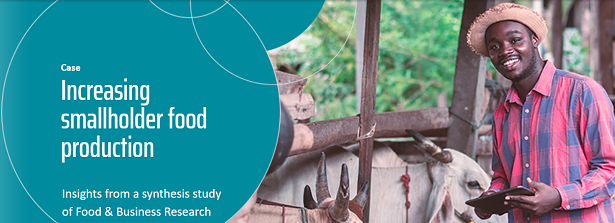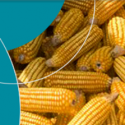Increasing smallholder food production

Smallholders play a vital role in contributing to food and nutrition security. It is estimated that they produce fifty to eighty per cent of the world’s food. Ironically, smallholders and their families are themselves among the poorest and most food insecure people in the global South.
This is the third outcomes paper “Smallholder outcomes for increased food production – Research innovations in agricultural inputs and technologies” of a larger series of publications commissioned by NWO-WOTRO, together forming a synthesis study of the Global Challenges Programme (GCP) and Applied Research Fund (ARF) projects under the Food & Business Research programme, executed by Daniëlle de Winter and Ellen Lammers.
This paper assesses the outcomes delivered by thirteen Food & Business Research (F&BR) projects in terms of increased food production by and for farming communities in seven African and two Asian countries.
Innovations: inputs and technologies
To increase food production, the paper looks at the relationship between inputs, technology and outputs. The input is what is used to produce food (from land and seeds to water, fertiliser and pesticides). The technology determines how inputs are turned into outputs. The output is what is produced (e.g. potato or cassava yield per acre, or milk yield per cow).
High risks of investing in new crops and practices
On the input side, the projects focused on selecting and introducing new and improved crop varieties that are resilient to changing climatic conditions, especially drought, as well as to pests and diseases. These factors highly impact smallholder farm productivity and thus the availability of food for both the household and market sales. In Uganda, improved varieties of cassava, cashew and sesame were selected, partly in close collaboration with the farmers. In Burundi, an improved seed potato variety was introduced alongside multiplication technologies to increase the farmers’ access to quality seed.
On the technology side, projects researched innovations to improve agricultural and dairy management practices, including through smart fertiliser use; disease and pest management; user-friendly irrigation technology; conservation agriculture; and improved storage for seeds, fodder and produce.
What triggers farmers to adopt innovations?
The reviewed projects showed a very high uptake of new and improved crop varieties among the target farmers, while the adoption of improved agricultural practices varied depending on farmers’ resources (time, labour & money). The analysis revealed key barriers and drivers for innovation adoption:
- Farmers’ risk perceptions concerning business and market prospects constituted a significant barrier to research uptake.
- Most reviewed projects involved the farmers in a participatory learning approach, sometimes building on their knowledge and practices (e.g. in conservation agriculture or animal health).
- Effective farmer organisation also proved a driver for research uptake.
- The buy-in from local governments was a third driver for research adoption.
The effects of innovation adoption on yield, income and Food & Nutrition Security (FNS)
Many of the farming communities targeted by the research projects had been experiencing low and unpredictable yields due to climate change impacts (e.g. erratic weather, drought, soil depletion) and high incidences of pests and diseases. The approach used by all projects to focus on enhancing inputs as well as technologies carries significant potential for achieving more stable and increased food production.
- In all projects reviewed where new varieties and agricultural practices were adopted, farmers’ yields increased.
- Where yields increased, there were indications of increased income and profitability for the farmers.
- The reviewed projects did not generate much information on whether increased production and incomes resulted in improved food and nutrition security.
A way forward
That higher income, thanks to higher farm productivity, will automatically lead to improved food and nutrition security is a persistent policy assumption that was not validated by the Food & Business Research projects reviewed. This assumption merits longitudinal empirical research dedicated to investigating risk perceptions, decision making processes and other socio-economic conditions influencing the lives of small-scale farmers. At the same time, the synthesis suggests that divorcing livelihood and nutrition outcomes can be an artificial undertaking in the everyday reality of smallholder farming systems where both parameters are intrinsically linked.
Future research projects should include the important issue of farmers’ risk perceptions in their project design, as this appeared to be a significant barrier to research uptake. The synthesis study will devote a separate article to the issue of risk management, to be published in late 2020/early 2021.
The reviewed projects had very positive outcomes in terms of increased yield and productivity. However, whether farmers will be able to benefit economically – and sustainably – from their increased productivity, depends for a large part on context factors such as access to markets, consumer demand and a favourable policy and infrastructure environment. Follow-up research for a selection of projects is recommended to achieve insight into these mechanisms. This can generate important information on the viability of change processes over time and the potential for upscaling of some of the promising innovations researched and introduced by the Food & Business Research projects.
Downloads
- Download the full paper “Smallholder outcomes for increased food production – Research innovations in agricultural inputs and technologies”
Authors: Daniëlle de Winter and Dr Ellen Lammers.






